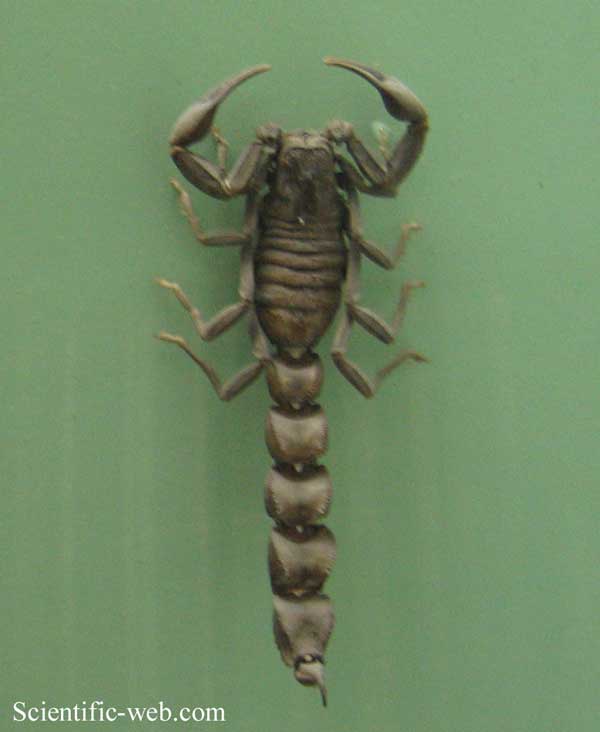
Androctonus crassicauda, Photo: Michael Lahanas
Superregnum: Eukaryota
Cladus: Unikonta
Cladus: Opisthokonta
Cladus: Holozoa
Regnum: Animalia
Subregnum: Eumetazoa
Cladus: Bilateria
Cladus: Nephrozoa
Cladus: Protostomia
Cladus: Ecdysozoa
Cladus: Panarthropoda
Phylum: Arthropoda
Subphylum: Chelicerata
Classis: Arachnida
Ordo: Scorpiones
Subordo: Neoscorpionina
Familia: Buthidae
Genus: Androctonus
Species: Androctonus crassicauda
Vernacular names
English: Arabian Fattail Scorpion
Maygar: Arab koverfarku skorpio
Androctonus crassicauda, the Arabian fat-tailed scorpion, is a species of dangerous scorpion usually found in North Africa and the Middle East.
Description
Androctonus crassicauda is a generalist desert species,[1] an Old World scorpion.[2] Adults can vary in colour from a light brown to reddish to blackish-brown, to black. They can grow to over 10 centimetres (3.9 in) in length.[1][3]
Distribution and habitat
This species is found mainly in the Palaearctic region, in such countries as Turkey,[4] Iran, and other southwestern Asian nations.[5][1] A. crassicauda lives in the ruins of old, neglected structures,[1] and was considered a potential hazard for troops during the Persian Gulf conflict, though it was an unaggressive species that had no reports of stings.[3] It also occurs in margins of desert (arid, semi-arid) places and sometimes accumulated vegetation debris.[6]
Behavior
A nocturnal scorpion, it hides in crevices and under objects during the day, and at night hunts insects and other invertebrates, or small lizards.[6]
Venom
The venom is mainly composed of neurotoxins, cardiotoxins, and possibly myotoxins. Victims of the sting have reported local effects (intense pain, redness and swelling). Systemic effects include heart malfunctions, remote internal bleeding, visual disturbance, and respiratory problems. Deaths mostly occur with respiratory arrest, heart failure, and shock.[6] The LD50 for this species is 0.08 mg/kg (IV) and 0.40 mg/kg (SC).[7]
Antivenom
Antivenom produced by this species has been used in Turkey to treat all scorpion stings since 1942.[2]
References
"Euscorpius" (PDF). Sciene.marshall.edu. Retrieved 2011-12-05.
"Dear Editor" (PDF). Archived from the original (PDF) on 2010-06-10. Retrieved 2011-12-05.
"Archived copy" (PDF). Archived from the original (PDF) on 2011-10-02. Retrieved 2011-12-05.
"Euscorpius" (PDF). Sciene.marshall.edu. Retrieved 2011-12-05.
"WRBU Scorpion Identification". Wrbu.si.edu. Archived from the original on 2012-02-04. Retrieved 2011-12-05.
"Living Hazards Database (LHD) – Search by Scientific Name" (PDF). Acq.osd.mil. Retrieved 16 March 2022.
Wilcox, Christie (2016-08-09). Venomous: How Earth's Deadliest Creatures Mastered Biochemistry. Farrar, Straus and Giroux. ISBN 978-0-374-71221-1.
Retrieved from "http://en.wikipedia.org/"
All text is available under the terms of the GNU Free Documentation License

